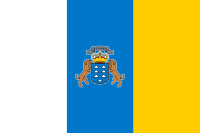
Photo from wikipedia
Abstract Canary Current Large Marine Ecosystem (CCLME) captures continue to increase. They are now reaching 3.5. million tonnes compared to 2.5 million tonnes 20 years ago. While demersal resources reached… Click to show full abstract
Abstract Canary Current Large Marine Ecosystem (CCLME) captures continue to increase. They are now reaching 3.5. million tonnes compared to 2.5 million tonnes 20 years ago. While demersal resources reached a plateau by the end of the 1990s, small pelagic resources continue to increase due to the quality of the up-welling in recent years and now represent 80% of the total catches. Distant water fleets have considerably reduced their presence in CCMLE waters and are progressively replaced predominantly by West African fleets of canoes. The importance of the migratory fishery is growing as a strategy to cope with the drastic decline of coastal fish stocks in key fishing nations such as Senegal and Gambia. They contribute to about 20% of the catches of the sub-Saharan countries of the CCLME despite not appearing in any statistic and not being regulated at both national and regional scales. Trade is also a concern as the main routes are still those toward Europe and Asia for the high value species while low value fish goes to African countries, mainly bordering the Gulf of Guinea. In that regard, the CCLME remains the fish tank of Europe and, to a lower extent, of Asia. Less than 1% of the total catches are traded within the CCLME countries, indicating the strength of trade barriers in place.
Journal Title: Environmental development
Year Published: 2020
Link to full text (if available)
Share on Social Media: Sign Up to like & get
recommendations!